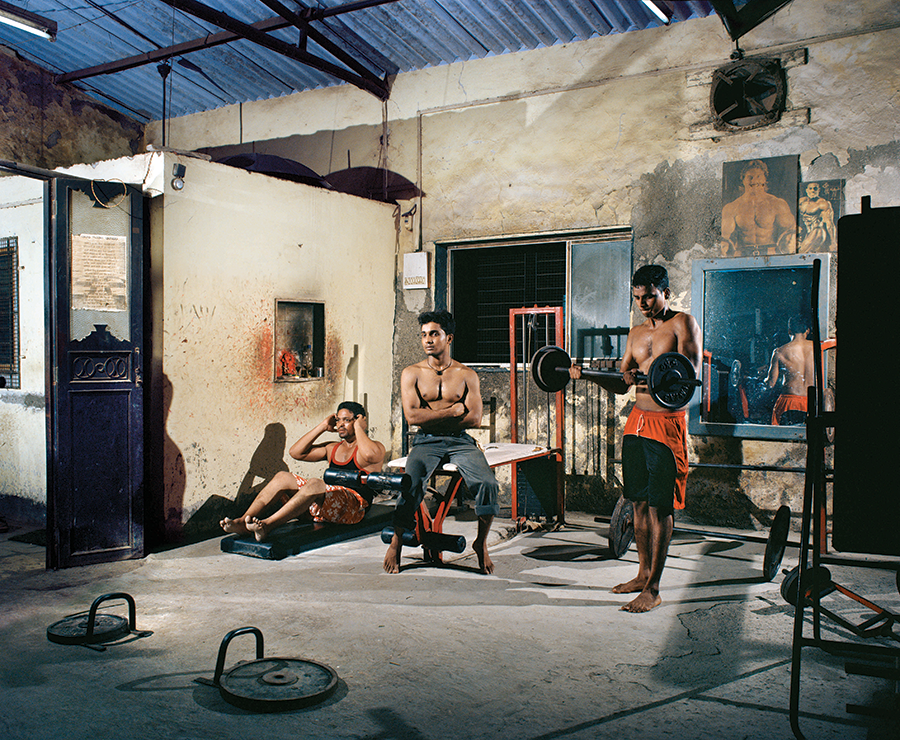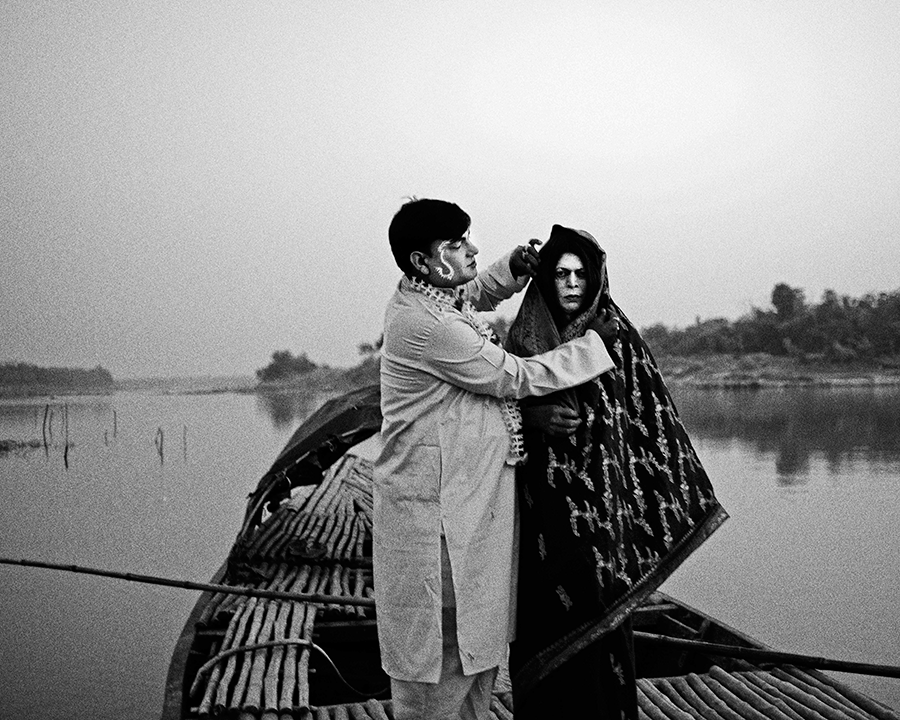
© Sheetal Mallar. Dabolim. Image courtesy Goa Photo.
Photography as we know it came into being in France, in the first half of the 19th century. Nicéphore Niépce and Louis Daguerre experimented with a series of light-sensitive chemicals all through the 1820s and 1830s until the latter fixed upon the metal-based process that bears his name. Formally introduced in 1839, the daguerrotype process required comparatively few minutes of exposure, and produced satisfactory clarity and detail, especially for portraiture executed under lights. Within two decades, the new technology was being used – and constantly refined and developed – throughout Europe and the USA.
From its inception, photography was recognised for its suitability in the colonial projects and self-image of the British Raj. The Bombay Photographic Society already had 200 members when it was formed in 1854 – most notably the brilliant 24-year-old Dr Narayan Daji Lad whose photographs were included in a landmark 1857 exhibition by the Photographic Society of Bengal.
No less a trailblazer than his better-known brother (the city museum of Mumbai is named after Dr Bhau Daji Lad), this young Indian was a persistent pioneer: first Indian faculty member of Grant Medical College, early sheriff of the city, a dedicated patron of vernacular literature and the arts. The Lad brothers avowedly embodied a newly emerged Indian cosmopolitanism and urbanity, an unprecedented “native” democratic engagement with the public sphere. Relatively unknown is how all this directly derived from their experience of growing up in Goa (the brothers went to Bombay from Pernem), where a decisive shift of power and control from the Portuguese colonial administration to Hindu and Catholic Goan elites already anchored a deeply-felt civitas.
Portugal’s heyday in India had been fleeting. There was undeniable grandeur on the cusp on the 16th century, when Lusitanian caravelas dominated the oceans from Mozambique to Manaus. Then, the city now known as Old Goa teemed more populous than contemporary Paris and London combined, the richest and most glittering entrepot the world had ever known. But just a century later, everything changed. The Dutch and British hacked away control of the more lucrative trade routes, and the Lisbon court’s interest switched to Brazil.
This rapid withering of Portuguese ability to project power into India required urgent compromises to sustain the rump Estado da India. So the last centuries of colonial rule in Goa unfolded a series of compacts between the enfeebled administration, and progressively dynamic and assertive native Goans. Pombaline reforms – particularly crucial was the expulsion of the Jesuits in 1759 – and British occupation between 1812 and 1815 were important milestones in this extended bargaining process. But nothing better illustrates the settlement imposed on the Portuguese in the course of their own regime than the unexpected rise of Panjim, the “New Goa” created from swamplands by a Civis Mundi new to India, the first self-consciously non-Western “world citizens”.
The gift of geography
Part of the reason it happened in Goa first is the cumulative result of geography. This fingernail-sized slice of the Konkan coast comprises excellent harbours on its rivers, and has been a point of contact with the outside world as far back as human history has been recorded. The Sumerians knew of Goa and possibly settled in numbers, the Arabs prized trade in the territory’s ports many centuries before Europeans built ships large enough to cross the oceans. The Adil Shah who was chased off in 1510, was a Mediterranean-born Turk. His admiral was a Polish Jew. Thus, the Goan reality was deeply multicultural before the word was invented, and ancient institutions like the proto-republican gaunkari – best described by DD Kosambi – additionally demonstrate that democratic values have very deep roots in this part of the world.
After the advent of European control, however, it is undoubtedly Portugal’s own (albeit halting) history of liberal constitutionalism that seeded Goa with Enlightenment ideas, several generations before they were planted in other parts of the subcontinent. From 1822 onwards, a series of Goan representatives argued for increased political freedom in Lisbon’s Cortes Gerais, the Portuguese Parliament itself. One of them, the polymathic Francisco Luis Gomes notably extended his claims to the rest of India, presaging Vivekananda by many years when he wrote (to the pre-eminent French intellectual of the times, Lamartine), “I was born in…the cradle of poetry, philosophy and history, now their tomb. I belong to that race which composed the Mahabharata and invented chess…but this nation which made codes of its poems and formulated politics in a game is no longer alive. It survives, imprisoned in its own country…I demand liberty and light for India!”
That brand of defiant self-confidence is bedrock to Panjim’s sense of identity. This city on the banks of the Mandovi is the Goan’s most eloquent argument, and strongest claim for his own distinct world view. In its laterite and plaster, public jardins and hidden courtyards, Panjim manifests the intricately layered, acutely globalised culture which makes Goa instantly, palpably different from any other place in India. This city defines its own civilisation.
Urban efflorescence
By 1843, when Panjim officially became the capital of Goa, the native Goans had the considerable upper hand against their nominal masters. The Viceroy could manage very little without approval from the Hindu financiers of his regime. The uncomfortable coziness of that relationship is writ everywhere in the urban landscape – even today the Mhamai Kamat house balconies thrust controllingly, elbows-distance from the Viceroy’s office in the Palacio Idalcao. It is in Panjim that freedom of religion and a common civil code were established, where state-sponsored education propelled ranks of Hindu and Catholic Goans into the highest echelons of state administration. They ran the state. They proceeded to build the city to suit their own tastes.
The development of Panjim in the 19th and early 20th century is engraved deep with Goan aspirations, especially the explicit desire for equal standing and self-respect, and what a historian of the city, Vasco Pinho, calls the native citizen’s “freedom from fear the like of which has existed perhaps nowhere else.” This meant an end to religious discrimination – and the first new Hindu temples built in Goa after centuries of suppression – but also the first free public library in Asia, the first medical college in India, a raucous and flourishing print culture in Portuguese and Marathi (and later Konkani), and the constant burgeoning of independence-minded nationalist consciousness (the Partido Indiana was founded more than 20 years before the similarly intended Indian National Congress was launched in Bombay in 1885).
Goan planners and administrators studied in Europe, travelled the world, and returned home to implement contemporary best practices in urban planning, city layout, drains and sewage, and public hygiene in Panjim. They endowed their beloved culture centre, the Instituto Vasco da Gama (now called Menezes Braganza Institute) with a stunning, highly contemporary collection of art including original paintings and lithographs by Renoir, Cezanne, Henri Rousseau, George Grosz and Camille Pissaro, along with the latest books in a half-dozen languages. In this way, an entirely unprecedented Indian public sphere was assembled in Goa that leaned both East and West simultaneously, with democratic idealism at its heart, with Panjim its most comprehensive articulation.

© Max Pinckers. Image courtesy Goa Photo.
Demand for photography exploded in mid-19th century Europe because the Industrial Revolution created a rapidly burgeoning middle class, seeking cheaper, faster, more accurate portraiture than old-fashioned painting. A similar process played out in Goa in the later years of the same century, where countless families sought to commemorate their own gentrification and independence. In that era of early Indian photography largely characterised by anthropological studies, archaeological documentation, and contrived studio photography, there is also a remarkable body of family photos of Goans in situ, comfortably poised between Europe and Asia, visibly ready to absorb whatever modernity would bring.
Along with Narayan Daji Lad, many other Goans took to photography scant years after its invention in Europe. The writer Allan de Noronha (alias Chhotebhai) has written about his great-grandfather, the photographer Manuel Xavier de Noronha leaving his native Aldona in 1854 “with a retinue of 300 bullock carts…his major customers were in the princely state of Rajputana, as they were among the few that could afford his photographic charges”.
Noronha’s countrymen were among the first professional photographers to operate in Rangoon, Karachi, and even Zanzibar, where AC Gomez opened a branch of his Goa-based studio in 1868. Another Goan, AX Trindade was a prized colorist at Raja Deen Dayal’s famous photography studio in Bombay. He then dedicated himself to painting, was appointed one of the first Indian faculty members of the JJ School of Art and came to be known as "the Rembrandt of the East", a highly acclaimed portrait painter who swung the door open for fellow Goans, Souza and Gaitonde to launch the Progressive Artists Movement of the 1940s.
Panjim’s renowned Souza & Paul photography studio opened for business in 1884, when the city was still in formation. Glass plates have given way to digital prints, but their business still thrives in the same location. Only some of the buildings in that Azad Maidan locality are new, and Souza & Paul’s iconic photographs of Panjim at the beginning of the 20th century demonstrate that the city has not changed unrecognisably even right into the 21st. Sparklingly new "Nova Goa" has indeed become quaint "Old Panjim" but the original intents of the city survive timeless: an ongoing dialogue between river and ocean, a cultural tapestry woven from many strands, a last redoubt of good manners and grace, a pocket-sized delight for boulevardiers that is always ready to embrace new and better ideas. Goa Photo has a chance to be remembered as one of these.

© Soumya Sankar Bose. Image courtesy Goa Photo.
This is the introductory essay for the catalogue of the first edition of Goa Photo, an international photography festival in multiple locations across Panjim and Reis Magos from February 25-March 7.












